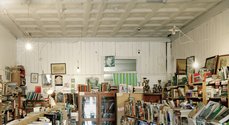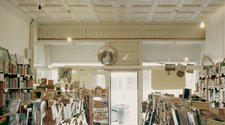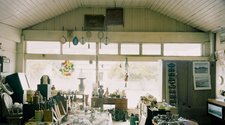John Hurrell – 22 June, 2011
The artist is especially interested in this variety of shop as a generic species, and indeed, though located in small remote townships, each image vividly reminds you of other shops you might regularly frequent (or used to) in much bigger cities. The premises and their contents seem interchangeable. Almost identical. It is unnerving.
Auckland Council Public Art Project
Allan McDonald
Arcade
20 May - 18 August 2011
This Allan McDonald exhibition continues the series of Auckland Council supported public art projects in Bledisloe Walkway, between Aotea Square and Wellesley Street. His five glowing photographs of the interiors of ‘junk’ shops feature a variety of displays of second-hand merchandise.
The horizontal rectangular images in lightboxes depict spaces presenting copious purchasable items, stacked high on floors, shelves or walls. They range from mirrors, books, and pictures to lamps, bedsteads, records and clothing. These objects - with their potential for a second life - recycled and hopefully reloved once more, are crammed in waiting to be discovered by admirers, available in a sea of plenitude.
McDonald’s images emphasise diversity, inventiveness in design functionality, and an ocular fascination with cluttered detail. Though obviously photographs showing a receding internal space, there is a painterly quality when the picture-plane (peppered with miscellaneous colourful items - such as in the image taken in Woodville) is accentuated.
The artist is especially interested in this variety of shop as a generic species, and indeed, though located in small remote townships, each image vividly reminds you of other shops you might regularly frequent (or used to) in much bigger cities. The premises and their contents seem interchangeable. It is unnerving.
The exhibition’s title refers to Walter Benjamin’s famous project about Parisian shopping malls in the first decade of the twentieth century, with their displays of new goods, but McDonald’s densely compact images are more about melancholy and owner/commodity histories, all jumbled up - looking back at the lost past rather than optimistically anticipating the future. (In Europe second-hand shops are not nearly as common as here; not so universally accepted in the culture. Probably because there is far greater social stigma attached to such items, like wearing second-hand clothes for example - part of the larger emphasis on class barriers and hereditary privilege.)
Interestingly the camera height for these frontally composed images is quite high; it seems slightly titled upwards and closer to the ceiling than the floor - for the latter is rarely seen while the former is usually readily apparent. You have a sense of bodily hovering over the display cases and racks, of floating above them, enjoying the individuality of each proprietor’s product range and their own quirky labelling, signage and organisation of stock.
As horizontal images the transparency proportions are slightly slot-like, giving the vague impression of looking out of a bunker, across the loaded up room towards the bleached pale outer windows facing the street and the entrance that introduces the customers. There is a wariness brought about by the camera position that is mixed in with the work’s shambolic beauty. This mood is accentuated by the knowledge that these shops are now in a state of siege - disappearing due to a variety of reasons, such as the growing effects of online communication, with digital technology replacing books and printed matter and Trade Me (or eBay) taking their clients.
McDonald’s fascinating photographs thus are not just historical documentation of a disappearing social phenomenon. They are more than that, in the sense that they exude a rhetorical stance in their physiology. A built-in politic is reflected in their design; psychological attitudes embedded in their compositional structure; content inseparable from form.
John Hurrell
Recent Comments
Kim Finnarty
Its seems to me that these images are also very much about light quality in a literal and metaphorical sense. ...





 Two Rooms presents a program of residencies and projects
Two Rooms presents a program of residencies and projects Advertising in this column
Advertising in this column



This Discussion has 1 comment.
Comment
Kim Finnarty, 8:15 p.m. 22 June, 2011 #
Its seems to me that these images are also very much about light quality in a literal and metaphorical sense.
There are more second hand shops in the European cities than here, they are usually attached to charities. One that I visited had the Police in it investigating a shoplifting incident, which seemed churlish to me.
Participate
Register to Participate.
Sign in
Sign in to an existing account.